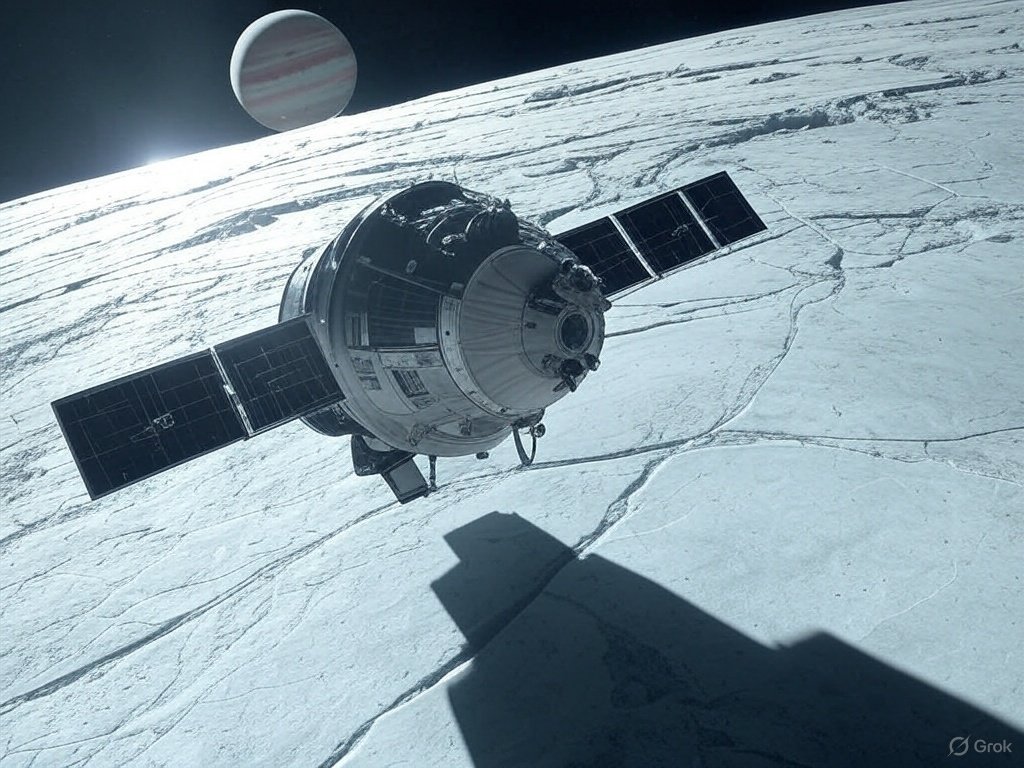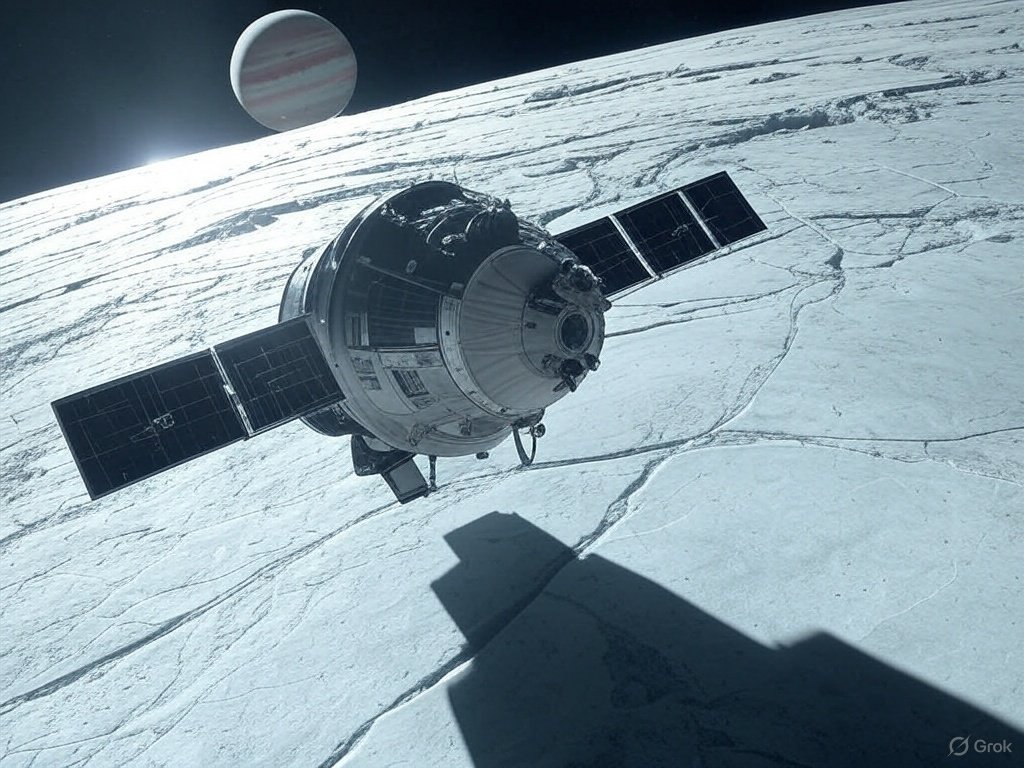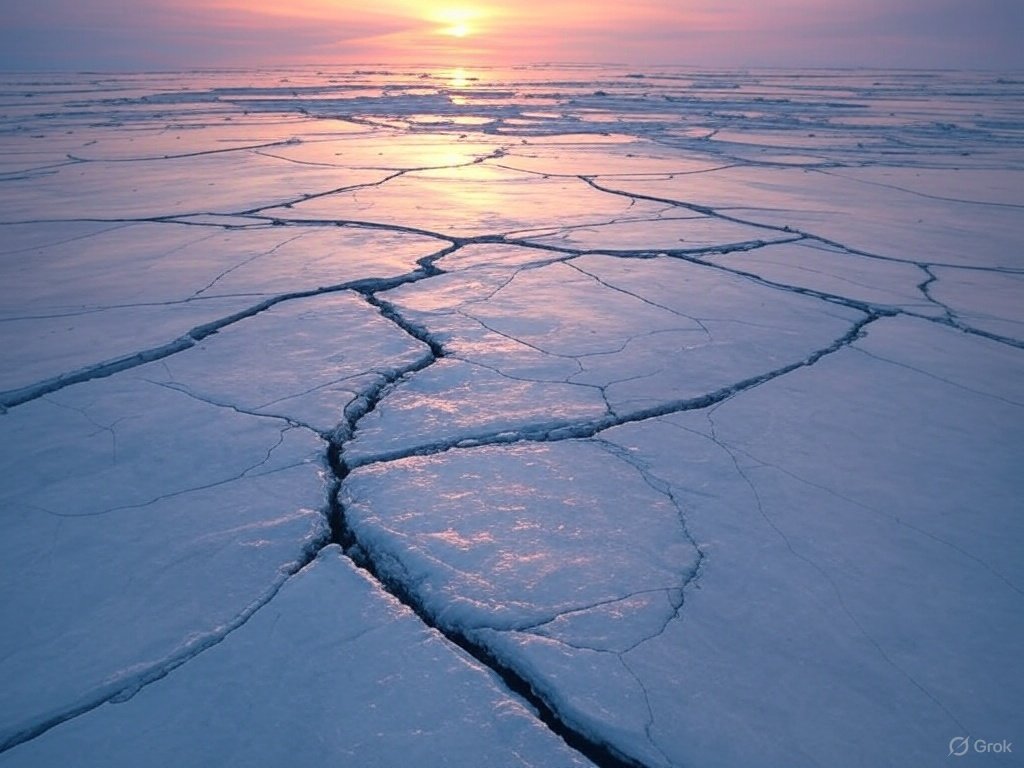If you step outside on a clear night and look up, the brightest planet visible in the sky is none other than Jupiter. This magnificent gas giant is the largest planet in our solar system and is known for its mesmerizing brightness. The reason for its strong visibility is the dense layers of reflective clouds that cover its surface, making it stand out even in a light-polluted sky. Unlike most other planets, you don’t even need a telescope to spot it—it shines so brilliantly that it’s often mistaken for a star!
But what makes Jupiter even more fascinating is its vast system of moons—a staggering 95 moons orbit around this giant planet, each unique in its own way. Some of these moons, like Io, Europa, Ganymede, and Callisto, are among the most intriguing celestial bodies in our solar system.
If you do happen to have a powerful telescope, you can even witness Jupiter’s four largest moons, known as the Galilean moons, from your own backyard. These moons were discovered by Galileo Galilei in 1610, and their movement around Jupiter provided some of the first concrete evidence that planets, including Earth, orbit the Sun rather than everything revolving around Earth—a groundbreaking realization at the time!
The Mystery of Europa – Could There Be Life?
Among all of Jupiter’s moons, Europa is perhaps the most intriguing. Scientists believe that beneath its thick icy crust lies a vast ocean of liquid water, potentially holding more than twice the amount of water on Earth. This raises one of the most exciting possibilities in modern space exploration—could there be extraterrestrial life beneath Europa’s frozen surface?
NASA’s studies have suggested that the ocean beneath Europa’s ice shell could be in direct contact with the moon’s rocky interior. This is significant because, on Earth, wherever water and rock interact, we often find microbial life thriving. If similar conditions exist on Europa, life—at least in microbial form—might already be present.
NASA’s Mission to Europa – A Historic Step
To explore this possibility, NASA launched the Europa Clipper Mission in October 2024. This mission is designed to orbit Jupiter while making multiple close flybys of Europa, gathering high-resolution images, studying its surface composition, and analyzing the salty ocean hidden beneath its icy shell.
The goal of this mission is to assess Europa’s habitability—to determine if it has the right conditions to support life. Although the Clipper mission won’t land on Europa, it will provide us with critical data that will help shape future missions, including potential robotic landers that could drill through the ice to explore the subsurface ocean.
A Once-in-a-Lifetime Opportunity – Sending My Name to Europa
In the months leading up to the mission’s launch, NASA made an unbelievable announcement—they would allow people from around the world to submit their names to be sent to Europa aboard the spacecraft. This meant that millions of names would be etched onto a microchip, attached to the spacecraft, and launched into space, eventually making their way to one of Jupiter’s most mysterious moons.
The moment I heard about this opportunity, I was beyond excited! I couldn’t believe that a part of me—a simple name—would be traveling to the outer solar system, reaching a place that is over 628 million kilometers (390 million miles) away from Earth.
For me, and for countless other space enthusiasts, this wasn’t just about sending a name to space—it was about being a part of human history, a part of something far bigger than ourselves. This was about being connected to the future of space exploration, knowing that when humanity looks back on this mission years from now, my name will be there, frozen in time, carried by a spacecraft traveling among the stars.
The Process – How My Name Will Reach Europa
NASA’s method of preserving and transporting these names is fascinating. Here’s how it works:
- Names Collection: People submitted their names through NASA’s official website. This opportunity was open for only a limited period, and once the deadline passed, submissions were closed.
- Microchip Encoding: All submitted names were carefully engraved onto a tiny microchip using advanced nanotechnology, ensuring that every name is precisely recorded.
- Attaching to a Metal Plate: The microchip is then secured onto a metal plate with a beautifully inscribed message, symbolizing our curiosity and drive to explore the universe.
- Placement on the Spacecraft: The metal plate, carrying the microchip, is then mounted onto the exterior of the Europa Clipper spacecraft, ensuring it will journey along with the mission.
- Launch and Space Travel: Once launched, the spacecraft will travel for several years before finally reaching Jupiter’s orbit, from where it will conduct detailed studies of Europa and its potential for life.
Why This Matters – A Small Step for Me, A Giant Leap for Humanity
This initiative by NASA is more than just a symbolic gesture—it represents the unity of humanity in our quest to explore the unknown. Think about it: we are sending our names to another world. While human travel to Europa may be far off in the future, our names will already be there, waiting for the day when astronauts or advanced robotic missions arrive.
For those of us who have always been fascinated by the wonders of the universe, this opportunity is deeply emotional. It reminds us that no matter how small we feel on this vast planet, we are a part of something cosmic, something grander than we can imagine.

Reflecting on the Journey – A Dream Come True
Even though the Europa Clipper mission is an unmanned spacecraft, just knowing that a tiny piece of me—my name—is traveling through space toward Jupiter’s moon is surreal. This is the closest connection I will ever have with the stars, and it fills me with a sense of wonder and pride.
I had planned to share this exciting news earlier, but due to my busy schedule, I couldn’t find the right moment. Also, I wasn’t sure if others would find it as thrilling as I do. But now, I’m certain that this is a moment worth sharing—because it’s not just about my name or NASA’s mission. It’s about all of us, about humanity reaching out to the cosmos, about dreams, discovery, and our endless pursuit of knowledge.
As I eagerly wait for the Europa Clipper to reach its destination, I feel honored to be a tiny part of this historic journey. This mission isn’t just about exploring Europa—it’s about inspiring future generations, pushing the boundaries of what we know, and reminding us that the universe is vast, mysterious, and full of possibilities.
Who knows? Maybe one day, humans will set foot on Europa, and when they do, they might look back at this mission and say:
“This is where it all began.”
And my name will already be there, waiting.
A Dream Etched in Space: My Name Aboard Europa Clipper
I still remember the first time I looked up at the night sky and felt that spark of wonder. As a child, I’d lie on the grass in my backyard, staring at the stars, imagining what might be out there—alien worlds, distant galaxies, or maybe even life beyond Earth. That curiosity has stayed with me, a quiet hum in the back of my mind. So when I heard about NASA’s name submission program for the Europa Clipper mission—offering me a chance to have my name etched on a microchip bound for one of Jupiter’s most mysterious moons—I didn’t hesitate. The moment I submitted my name, a wave of excitement washed over me. This wasn’t just a cool gimmick; it was a chance to be part of something monumental, something that could reshape how we see the universe.
The idea that my name will be aboard a spacecraft, hurtling through the vastness of space to Europa, feels almost surreal. It’s like a childhood dream I didn’t even know I had, suddenly coming to life. I can picture it: the Europa Clipper, sleek and purposeful, carrying a tiny piece of me—and millions of others—on a journey to explore the unknown. That thought alone fills me with a giddy, uncontainable thrill.

The Historical Significance of Europa Clipper
The Europa Clipper mission is so much more than a personal milestone; it’s a historic endeavor that could mark a turning point in humanity’s exploration of space. Europa, one of Jupiter’s largest moons, has long fascinated scientists with its cracked, icy surface and the tantalizing possibility of a subsurface ocean. This isn’t just any ocean—it’s thought to hold twice the volume of all Earth’s oceans combined, hidden beneath a thick shell of ice. The mission’s goal is ambitious yet awe-inspiring: to study Europa’s ice shell, map its surface, and probe that hidden ocean for clues about its composition and potential habitability. With tools like ice-penetrating radar and spectrometers, the spacecraft will peel back the layers of this enigmatic moon, searching for answers to one of humanity’s oldest questions: Are we alone?
This mission feels like a chapter in a much larger story. Space exploration has always been about pushing boundaries—from Galileo peering through his telescope to the Apollo missions landing on the Moon, and now to spacecraft venturing into the outer solar system. Europa Clipper fits right into that legacy, carrying forward our collective curiosity and drive to understand the cosmos. If it finds even a hint of conditions suitable for life, it could redefine our place in the universe. Knowing my name is part of that effort makes me feel connected to something timeless, a shared human quest that stretches across generations.
Hopes for Space Exploration
Participating in this program has sparked a flood of thoughts about what space exploration could mean for our future—and I can’t help but feel hopeful. The possibility of discovering life on Europa, even if it’s just simple microbes, sends shivers down my spine. Imagine the moment when the data comes back, and scientists announce, “We’ve found something.” It would be a seismic shift, a spark that ignites new questions and dreams about what else might be out there.
But my hopes go beyond Europa. I dream of a future where humanity takes its next steps into the solar system—settlements on Mars, outposts on distant moons, or even missions that reach beyond our Sun’s grasp. Each spacecraft we send, like Europa Clipper, lays the groundwork for those possibilities. The technology developed for these missions often ripples back to Earth, too—think of solar panels, GPS, or medical advancements born from NASA’s work. Studying Europa’s icy environment could even teach us more about our own planet’s changing climate.
For me, having my name on this spacecraft is a small but meaningful thread in that tapestry of progress. It’s a symbol of connection—not just to the mission, but to everyone who looks up and wonders. Millions of names will travel together on Europa Clipper, a collective shout into the void that says, “We’re here, and we want to know more.” That sense of unity, of being part of something bigger, fuels my excitement and optimism for what’s to come.

A Childhood Memory and a Full-Circle Moment
Submitting my name brought back a vivid memory from years ago. I was at a stargazing event with my family, peering through a rickety telescope as a volunteer pointed out Jupiter. I remember gasping as I saw it—a bright, banded orb with four tiny dots nearby: its largest moons, including Europa. Back then, those dots were just specks of light, but they felt like a secret the universe was whispering to me. I was hooked. Years later, adding my name to the Europa Clipper mission felt like closing a loop. That wide-eyed kid staring at Jupiter could never have imagined she’d one day send a piece of herself to explore one of those very moons. It’s a quiet, personal triumph that makes this experience all the more special.
Looking to the Future
When Europa Clipper launches and finally reaches its destination in 2030, I’ll be watching with bated breath. What will it find? Signs of life? Clues to an alien ocean’s chemistry? Or maybe just more questions to fuel the next mission? Whatever the outcome, I’ll know that a tiny part of me is out there, riding along on this incredible journey. And maybe—just maybe—my name being on that spacecraft will inspire someone else, a kid lying on the grass somewhere, to look up and dream.
The future of space exploration feels bright. Missions to Mars, the outer planets, and even interstellar probes are on the horizon. Each one builds on the last, pulling us closer to answers about life, the universe, and our potential among the stars. Europa Clipper is a stepping stone, and being part of it makes me feel like I’m contributing, however small, to that grand adventure.
In the end, participating in NASA’s name submission program for Europa Clipper is more than a fun perk—it’s a deeply personal connection to a historic moment. It’s the thrill of seeing my name etched in space, the weight of a mission that could change everything, and the hope that we’re just at the beginning of an extraordinary era. As the spacecraft carries my name—and millions of others—to Europa, it’s a reminder that we’re all explorers in our own way, united by curiosity and a shared dream of reaching for the stars. And for that, I couldn’t be more excited.
A Name Among the Stars: Reflections on Jupiter, Europa, and the Journey Beyond

On a crisp, clear night, I step outside and lift my gaze to the heavens. The sky unfurls before me, a vast tapestry of inky black, pierced by the faint glimmer of stars—each a whisper from a distant corner of the cosmos. Among them, one light shines brighter, unwavering, drawing my eye like a lodestone. It’s Jupiter, the titan of our solar system, reigning supreme in the night. Through the lens of a telescope, it reveals itself: a golden orb streaked with amber bands, its ancient storms swirling in timeless chaos. Nearby, four tiny moons orbit in quiet devotion, and there, among them, is Europa—its icy surface gleaming faintly, a cracked and frozen enigma veiling secrets beneath.
As I fix my eyes on Europa, a shiver of wonder courses through me. Soon, a spacecraft—the Europa Clipper—will journey to that distant moon, bearing a microchip etched with names from Earth. My name is among them. It’s a humble mark, a mere word, yet it feels like a bridge spanning the infinite. I stand here, rooted to this small blue planet, while a fragment of my identity hurtles toward the unknown, carried on humanity’s boldest dreams. I am no explorer in the flesh, but in spirit, I am bound for Europa’s shores, a passenger on this voyage through the void.
The awe of space washes over me like a tide. Above, the universe stretches endlessly—stars igniting and fading, galaxies spinning in silent majesty, mysteries unfolding beyond the grasp of our fleeting lives. It’s a realm so grand it dwarfs us, reducing our worries to whispers in the wind. Yet, in its vastness, I find connection. To look up is to tap into a primal yearning, a shared human pulse that beats through time: the urge to explore, to question, to reach beyond. Jupiter and Europa, glowing softly in the night, are not just celestial bodies—they are beacons of that longing, calling us to peer into the abyss and wonder what lies beyond.

Europa, especially, stirs the imagination. Beneath its fractured icy shell lies an ocean, dark and profound, a hidden world that might cradle life in its depths. The Europa Clipper isn’t merely a machine; it’s a messenger sent to probe one of humanity’s deepest riddles: are we alone? The thought that my name rides along on this quest fills me with quiet pride and trembling hope. What might we find in those alien waters? Microbes drifting in the dark? Evidence that life blooms beyond our fragile sphere? I am tethered to this possibility, a small but willing part of a mission that could rewrite our place in the cosmos.
There’s a kinship in this journey, too. My name joins millions of others, a constellation of voices etched together, a collective offering to the stars. We are bound by this act—not as individuals, but as a species, united in curiosity and courage. Though I’ll never touch Europa’s ice or hear the hum of the spacecraft’s engines, I am part of its story. It’s a legacy that stretches beyond me, linking the hands that built the mission, the minds that dreamed it, and the generations who will one day marvel at its revelations.
Standing beneath this boundless sky, Jupiter and Europa take on new meaning. They are no longer distant lights, but waypoints on a path I’ve joined. The universe feels less like an untouchable expanse and more like a shared frontier. My name, carried on that tiny chip, will drift through the silence of space, past the pull of Earth, into the orbit of a moon that might hold the secrets of life itself. And here, gazing upward, I feel the weight of that wonder—the thrill of being part of something vast, something eternal.

For now, I linger in the night, the cool air brushing my skin, the stars winking above. Jupiter blazes, Europa glints, and I am struck by the beauty of it all—the grandeur of space, the audacity of our dreams, and the quiet honor of knowing a piece of me is bound for the stars. In this moment, I am small, yes, but I am also infinite, woven into the fabric of a universe that beckons us ever onward.